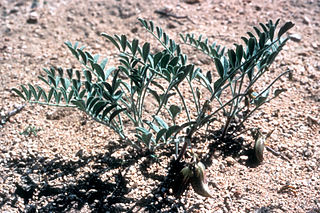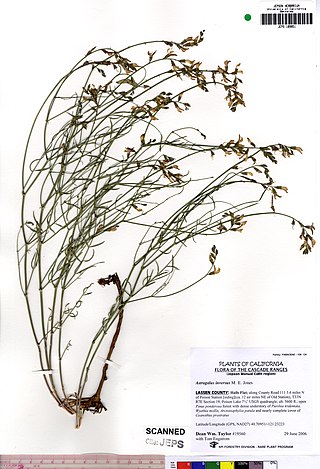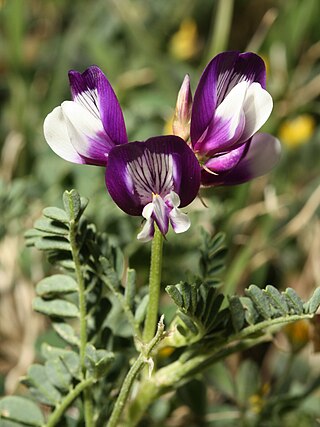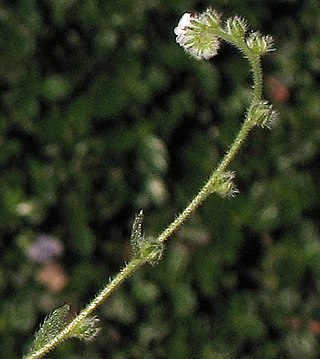
Eryngium aristulatum, known by the common names California eryngo and Jepson's button celery, is a species of flowering plant in the family Apiaceae.

Astragalus pycnostachyus var. lanosissimus, the Ventura marsh milk-vetch, is a short-lived, herbaceous perennial in the pea family Fabaceae,

Astragalus lentiginosus Astragalus lentiginosus is a species of legume native to western North America where it grows in a range of habitats. Common names include spotted locoweed and freckled milkvetch. There are a great number of wild varieties. The flower and the fruit of an individual plant are generally needed to identify the specific variety.

Astragalus trichopodus is a species of legume known by the common name Santa Barbara milk vetch. It is native to southern California and Baja California, where it grows in several types of open habitat, including in the Transverse Ranges and Mojave Desert.
Astragalus anxius is a rare species of milkvetch known by the common names troubled milkvetch and Ash Valley milkvetch. It is endemic to northern Lassen County, California, where it is critically imperiled. It was formally described in 1992.

Astragalus asymmetricus is a species of milkvetch known by the common name San Joaquin milkvetch. It is endemic to California, where it grows in grassy and disturbed areas in the Central Valley and nearby parts of the Central Coast Ranges and San Francisco Bay Area.

Astragalus brauntonii is a rare species of milkvetch known by the common name Braunton's milkvetch. It is endemic to California, where it is known from fewer than 20 extant occurrences in the hills and mountains surrounding the Los Angeles Basin in Southern California, as well as an isolated population in northern Baja California. This is a federally listed endangered species in the United States.

Astragalus ertterae is a rare species of milkvetch known by the common name Walker Pass milkvetch. It is endemic to California, where it is known from only three occurrences near Walker Pass in the Sierra Nevada. It is endangered by trampling, trail use, and also grazing.

Astragalus inversus is a species of milkvetch known by the common name Susanville milkvetch.

Astragalus jaegerianus is a rare species of milkvetch known by the common name Lane Mountain milkvetch. The plant was named for the biologist Edmund Jaeger, who first documented it in 1939.

Astragalus kentrophyta is a species of milkvetch known by the common name spiny milkvetch. It is native to western North America from central to west Canada, to California, to New Mexico. It grows in rocky mountainous areas, such as the Sierra Nevada, and on plateaus.

Astragalus nuttallianus is a species of milkvetch known by the common names smallflower milkvetch and turkeypeas. It is native to the southwestern and south central United States and northern Mexico, where it can be found in many types of habitat, often in dry areas.

Astragalus nuttallii is a species of milkvetch known by the common name Nuttall's milkvetch. It is native to California and Baja California, where it grows in the sandy soils of coastal habitat. This is a perennial herb forming thick, tangled clumps of hairy to hairless stems up to a meter in length. The abundant leaves are up to 17 centimeters in length and made up of many oval-shaped leaflets. The inflorescence is a large, dense body of up to 125 flowers, each around 1 to 1.5 centimeters long. The flowers are dull cream-colored and sometimes purple-tinted. The fruit is an inflated legume pod up to 6 centimeters long which dries to a papery texture and contains many seeds in its single chamber. One variety of this species, the ocean bluff milkvetch is endemic to the Central Coast of California.

Astragalus oxyphysus is a species of milkvetch known by the common name Mt. Diablo milkvetch or Stanislaus milk-vetch. It is endemic to central California, where it grows in dry grassland and scrub habitat in the Central Valley and the adjacent Inner Coast Ranges and Sierra Nevada foothills.

Astragalus purshii is a species of milkvetch known by the common names woollypod milkvetch and Pursh's milkvetch.

Chaenactis glabriuscula, with the common name yellow pincushion, is a species of flowering plant in the daisy family. It is native to California and Baja California.

Plagiobothrys collinus is a species of flowering plant in the borage family known by the common name Cooper's popcornflower.

Astragalus desereticus is a rare species of milkvetch known by the common name Deseret milkvetch. It is endemic to Utah County, Utah, where it is known from only one population. It was thought to be extinct until 1981 when this population was discovered. The population contains 5,000 to 10,000 plants on an area of land covering less than 300 acres. It is vulnerable to damage from grazing cattle, which eat the plant and trample the soil, and from development and erosion. This is a federally listed threatened species.

Astragalus limnocharis var. montii, synonym Astragalus montii, is a rare variety of flowering plant in the legume family. It is known by the common name Monti's milkvetch. It is endemic to Utah in the United States, where there are only three known populations. Under the synonym A. montii, it is a federally listed threatened species of the United States.

Astragalus lentiginosus var. iodanthus, synonym Astragalus iodanthus, is a variety of Astragalus lentiginosus, a flowering plant in the legume family, Fabaceae. It is known by the common names Humboldt River milkvetch and violet milkvetch. It is native to the western United States, where its range includes California, Idaho, Nevada, Oregon, and Utah. It grows on hills and in valleys in barren sandy and volcanic soils in habitat such as sagebrush.




















